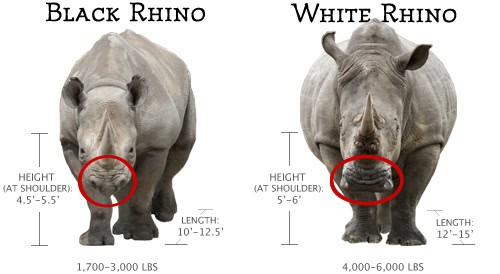It is a common question that clients have asked me over my years of guiding : What is the Difference between the Black and White Rhino, is it not the colour?
To show clients other the clear difference this is the best diagram I could find (Above).
Firstly I will start with a bit of the history behind the name “Black Rhino vs White Rhino”.
When the Dutch settlers moved into the area of Durban or Kwa-Zulu Natal roughly 1838, they came across these beasts and named the White Rhino – WEID Rhinoster basically meaning WIDE Rhino referring to the Lip(mouth) being Wide.
This is clearly seen in the diagram above.
The English then heard this and misinterpreted what the Dutch were saying and ended up calling the “Weid” Rhinoster – White, “Weid” of course sounding like “White”.
Of course from here all meaning was lost and to keep things simple the other Rhino, was called Black.
There is NO difference in colour between the two species they are both Grey/Black unless they mud-wallow in Iron rich Red clay bases soil… Then they are Red in Colour.
As scene in the diagram Black Rhino has a prehensile hooked lip for feeding on leaves and twigs. It is smaller is stature, more rare and its head is fixed higher up as it is a browser.
It is also found in thicker habitats usually: Riverine forest where there food is readily available. Of course they do NOT read books and with habitat loss they can be found in open areas as well if there is little food available.
Black Rhino also have much rounder ears and there second horn is larger in comparison to the White Rhinos Second Horn.
White Rhino being larger feeds on Grass only like a lawn mower, it has a wide or Square lip and its head is fixed low to the ground but a gristly muscular section behind the head.
They are not as rare as the Black Rhino but still endangered and rapidly diminishing in number due to the Asia trade in Rhino Horn for Medicines.
There ears are cone shaped and move independently so they can hear things all around them in the open areas where they feed.
Rhinos both Black Rhino and White Rhino have the thickest skin of any land mammal even the African Elephant, averaging 2.5 CM over the whole body.
In closing they are two distinct species and it is actually the Black Rhino which is the one which features as one of the BIG 5, but due to its difficulty in spotting we all have reverted to including White Rhino as one of the Big 5 even though it is not as dangerous as the Black Rhino.
Tim Brown Tours
Big 5 Safaris Durban, Big 5 Safaris Kwa-Zulu Natal, Big 5 Tours Kwa-Zulu Natal, Bush experience, Bush Safaris, bush tours, Drakensberg Hiking Tours, drakensberg tours, Durban Big 5 Safari, Durban Big 5 Safaris, Durban Bush Safaris, Durban Bush Tours, Durban City Tours, Durban Cultural Tours, Durban experiences, Durban Safaris, Durban Shark Cage Diving, Durban Tours, Durban Township Tour, Guiding Ethics, Hluhluwe Umfolozi Tours, Imfolozi Game reserve, Individual Tours Durban, Kwa-Zulu Natal Battlefield Tours, Kwa-Zulu Natal Bush Tours, Kwa-Zulu Natal Cultural Tours, Kwa-Zulu Natal Safaris, Mountain Tours, Personalised Tours Durban, Private Tours Durban, Private Tours Kwa-Zulu Natal, Private Tours South Africa, St Lucia, St Lucia Tours, Tala game reserve Tours, things to do Durban, Tours Durban, Tours South Africa, White Rhino, Black Rhino.



